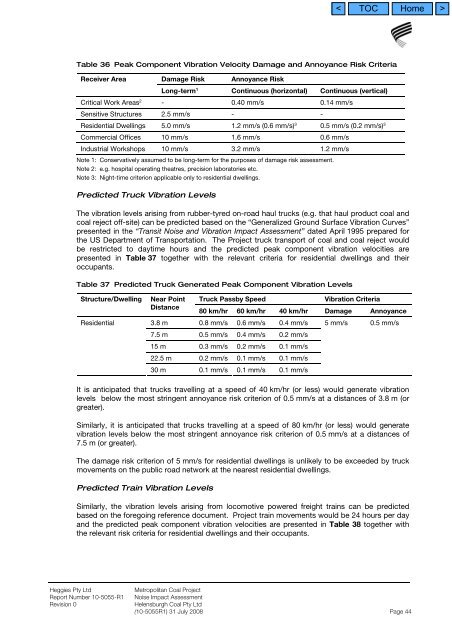Appendix J - Peabody Energy
Appendix J - Peabody Energy
Appendix J - Peabody Energy
You also want an ePaper? Increase the reach of your titles
YUMPU automatically turns print PDFs into web optimized ePapers that Google loves.
Table 36 Peak Component Vibration Velocity Damage and Annoyance Risk Criteria<br />
Receiver Area<br />
Damage Risk<br />
Annoyance Risk<br />
Long-term 1 Continuous (horizontal) Continuous (vertical)<br />
Critical Work Areas 2 - 0.40 mm/s 0.14 mm/s<br />
Sensitive Structures 2.5 mm/s - -<br />
Residential Dwellings 5.0 mm/s 1.2 mm/s (0.6 mm/s) 3 0.5 mm/s (0.2 mm/s) 3<br />
Commercial Offices 10 mm/s 1.6 mm/s 0.6 mm/s<br />
Industrial Workshops 10 mm/s 3.2 mm/s 1.2 mm/s<br />
Note 1: Conservatively assumed to be long-term for the purposes of damage risk assessment.<br />
Note 2: e.g. hospital operating theatres, precision laboratories etc.<br />
Note 3: Night-time criterion applicable only to residential dwellings.<br />
Predicted Truck Vibration Levels<br />
The vibration levels arising from rubber-tyred on-road haul trucks (e.g. that haul product coal and<br />
coal reject off-site) can be predicted based on the “Generalized Ground Surface Vibration Curves”<br />
presented in the “Transit Noise and Vibration Impact Assessment” dated April 1995 prepared for<br />
the US Department of Transportation. The Project truck transport of coal and coal reject would<br />
be restricted to daytime hours and the predicted peak component vibration velocities are<br />
presented in Table 37 together with the relevant criteria for residential dwellings and their<br />
occupants.<br />
Table 37 Predicted Truck Generated Peak Component Vibration Levels<br />
Structure/Dwelling<br />
Residential<br />
Near Point<br />
Distance<br />
Truck Passby Speed<br />
Vibration Criteria<br />
80 km/hr 60 km/hr 40 km/hr Damage Annoyance<br />
3.8 m 0.8 mm/s 0.6 mm/s 0.4 mm/s<br />
7.5 m 0.5 mm/s 0.4 mm/s 0.2 mm/s<br />
15 m 0.3 mm/s 0.2 mm/s 0.1 mm/s<br />
22.5 m 0.2 mm/s 0.1 mm/s 0.1 mm/s<br />
30 m 0.1 mm/s 0.1 mm/s 0.1 mm/s<br />
5 mm/s 0.5 mm/s<br />
It is anticipated that trucks travelling at a speed of 40 km/hr (or less) would generate vibration<br />
levels below the most stringent annoyance risk criterion of 0.5 mm/s at a distances of 3.8 m (or<br />
greater).<br />
Similarly, it is anticipated that trucks travelling at a speed of 80 km/hr (or less) would generate<br />
vibration levels below the most stringent annoyance risk criterion of 0.5 mm/s at a distances of<br />
7.5 m (or greater).<br />
The damage risk criterion of 5 mm/s for residential dwellings is unlikely to be exceeded by truck<br />
movements on the public road network at the nearest residential dwellings.<br />
Predicted Train Vibration Levels<br />
Similarly, the vibration levels arising from locomotive powered freight trains can be predicted<br />
based on the foregoing reference document. Project train movements would be 24 hours per day<br />
and the predicted peak component vibration velocities are presented in Table 38 together with<br />
the relevant risk criteria for residential dwellings and their occupants.<br />
Heggies Pty Ltd<br />
Report Number 10-5055-R1<br />
Revision 0<br />
Metropolitan Coal Project<br />
Noise Impact Assessment<br />
Helensburgh Coal Pty Ltd<br />
(10-5055R1) 31 July 2008 Page 44

















